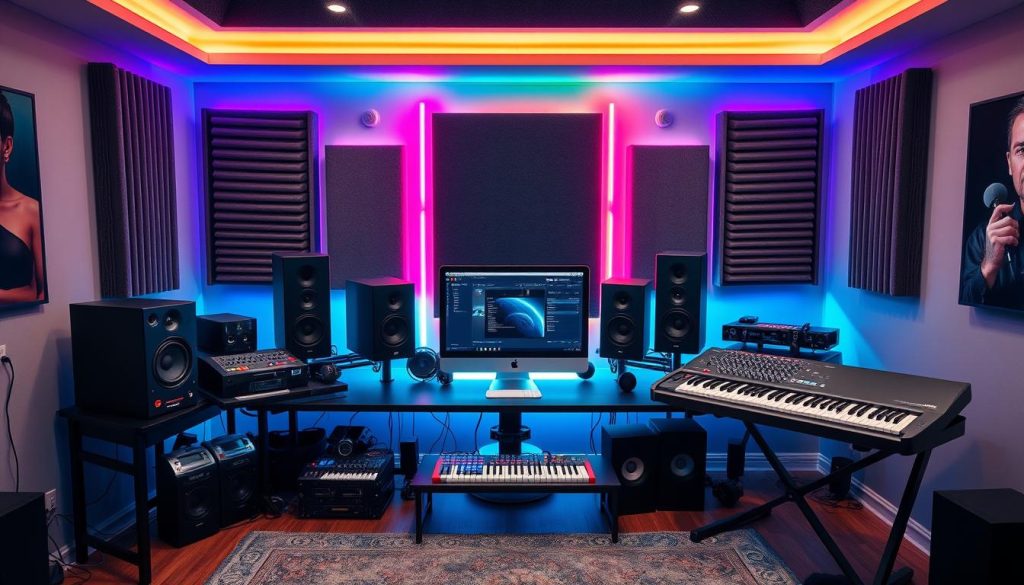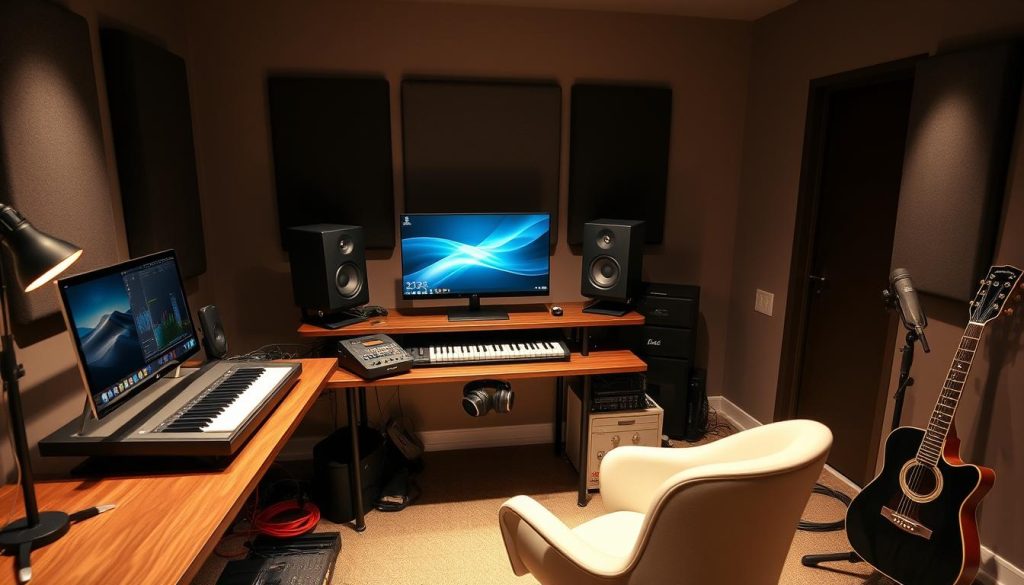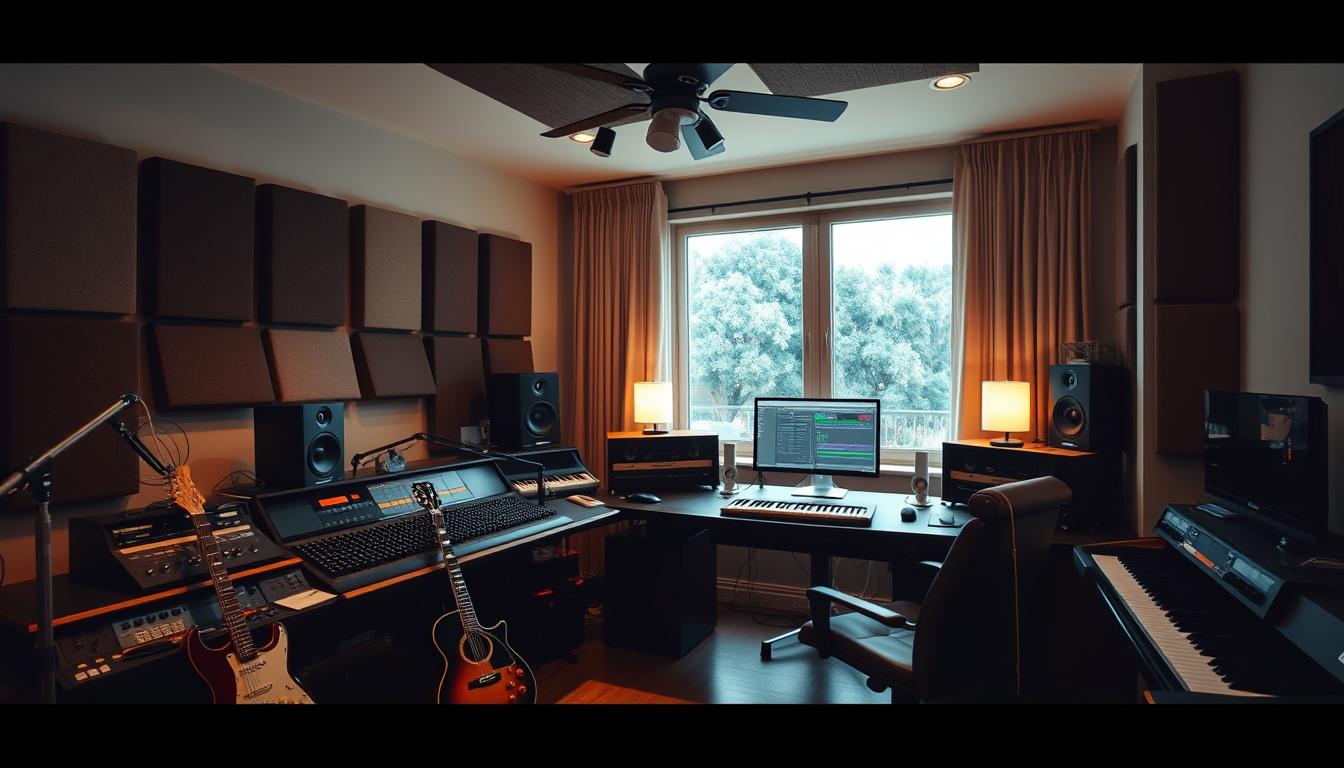Now, making a professional-quality home recording studio is easier than before. Thanks to digital tech, I can get great sounds without spending a lot. This guide will help me set up my dream studio. I’ll learn how to pick the best space and gear, and how to make my studio creative and efficient.
It doesn’t matter if I’m a singer-songwriter, producer, or just starting out. I’ll discover how to make a recording space that’s just right for me, without breaking the bank.
Space and Room Acoustics for a Home Recording Studio
Creating a great home recording studio is not just about the gear. The room’s size and sound quality are key. Think about what you’ll be recording in. This helps pick the best room size.
Choosing the Right Room Size
Bigger rooms are good for recording many instruments at once. Musicians can move around easily. But, a small room can be perfect for solo artists or small groups. You want enough space for good sound but not so big it’s hard to manage.
Avoiding Low Ceilings and Square Rooms
Don’t forget about the room’s shape and ceiling height. Low ceilings and square rooms can make sounds muddy and cancel out frequencies. Rooms that are long and tall, like 1:1.6 or 1:1.8, sound best. Using acoustic panels and diffusers can help, but a good room shape is best.
| Room Dimension | Ideal Range | Potential Issues |
|---|---|---|
| Room Size | 300-600 square feet | Larger spaces may require more acoustic treatment, while smaller rooms can struggle with low-frequency buildup. |
| Ceiling Height | 9-12 feet | Low ceilings can create reflections and standing waves, while very high ceilings may result in a cavernous, echoey sound. |
| Room Shape | Rectangular, with a height-to-width ratio of 1:1.6 or 1:1.8 | Square rooms and irregular shapes can lead to acoustic problems like frequency buildup and resonance. |
Choosing the right room size and shape helps you make clear, balanced recordings. Add good acoustic treatment, and you’re ready for a pro-quality home studio.
Computer and Software Requirements

Setting up your home recording studio starts with a good computer. It’s the heart of your music production. You need a system with certain specs to run music software smoothly.
Recommended PC Specifications
Start with a computer that has at least 8GB of RAM and a quad-core processor. Use solid-state drives (SSDs) for quick boot times and fast performance. These specs help your music production software and home studio computer run well.
Digital Audio Workstation (DAW) Options
Choosing the right software to record, edit, and mix your music is key. For best DAW for beginners, you have many free and paid options. Try out Pro Tools, Logic Pro, Cubase, Ableton Live, and FL Studio to see which music production software suits you best.
| DAW Software | Pricing | Key Features |
|---|---|---|
| Pro Tools | $299 (perpetual license) | Industry-standard DAW, comprehensive features, professional-grade |
| Logic Pro | $199 (one-time purchase) | Powerful DAW for macOS, extensive virtual instrument and effect plugins |
| Cubase | $99 – $599 (depending on version) | Versatile DAW with advanced MIDI and audio editing capabilities |
| Ableton Live | $99 – $449 (depending on version) | Unique workflow for electronic music production and live performance |
| FL Studio | $99 – $899 (depending on version) | Renowned for its piano roll and integrated music production tools |
Essential Audio Equipment for home recording studio

Setting up a home recording studio means picking the right audio gear for great sound. The audio interface connects your instruments and mics to your computer. Think about how many inputs and outputs you need. Also, consider features like built-in preamps and MIDI connectivity. A 2-in, 2-out interface is a good start for most studios.
Selecting an Audio Interface
The audio interface you pick is key to your recording quality. Look for an interface with:
- Enough input and output channels for your gear
- Quality preamps to boost your mic signals
- MIDI connectivity for your keyboards and other devices
- Works with your favorite Digital Audio Workstation (DAW) software
Great options for home studios include the Focusrite Scarlett 2i2, Steinberg UR22C, and Universal Audio Apollo Twin.
Studio Monitors and Headphones
Studio monitors and quality headphones are also crucial. They help you listen to your music accurately. Choose speakers and headphones that give you a true sound. Top picks for home studios are the Yamaha HS5 speakers, Sennheiser HD 6 Series headphones, and AKG K240 Studio headphones.
| Product | Description | Price |
|---|---|---|
| Focusrite Scarlett 2i2 | 2-in, 2-out USB audio interface with high-quality preamps | $159.99 |
| Yamaha HS5 | 5-inch powered studio monitor with a flat, accurate frequency response | $249.99 |
| Sennheiser HD 6 Series | High-performance, open-back headphones for critical listening | $199.95 |
Microphones and MIDI Controllers
No home recording setup is complete without a quality microphone (or two) for capturing vocals, acoustic instruments, and other sound sources. Investing in the right home studio microphones can make a big difference in your recordings.
Microphone Types for Vocals and Instruments
For best mics for home recording, consider a few key types. Condenser microphones are great for vocals and delicate instruments. They capture every detail of your performance, perfect for singing, acoustic guitars, and more.
Dynamic microphones are better for loud sounds like electric guitars, drums, and live performances. They’re tough and can handle loud sounds easily. They’re also great for podcasting because of their durability.
A MIDI keyboard for home studio is also key for making music. It lets you play virtual instruments and control your recording setup. This opens up more creative options for you.
Choosing the right microphones and MIDI controllers changes your recording game. Do your research and invest in the best for your needs. This way, you’ll make professional-sounding music from your home studio.
Cables, Stands, and Additional Gear
Building my home recording studio, I found out that there’s more to it than just the main gear. Quality XLR cables are key for connecting my mics. I also need sturdy mic stands to keep them in the right spot. A reliable pop filter helps make my vocals sound better.
I added isolation pads for my studio monitors to keep the sound clean. These pads stop unwanted vibrations and boost sound quality. For quiet recording times, I got a soundproof booth for my vocals. These home studio accessories have made my essential home studio gear even better in my basic home studio setup.
With these must-have cables, stands, and more, I’m ready to record top-notch audio. These extras have really improved how well my studio works and sounds. They’ve made a big difference in my recording space’s performance.

